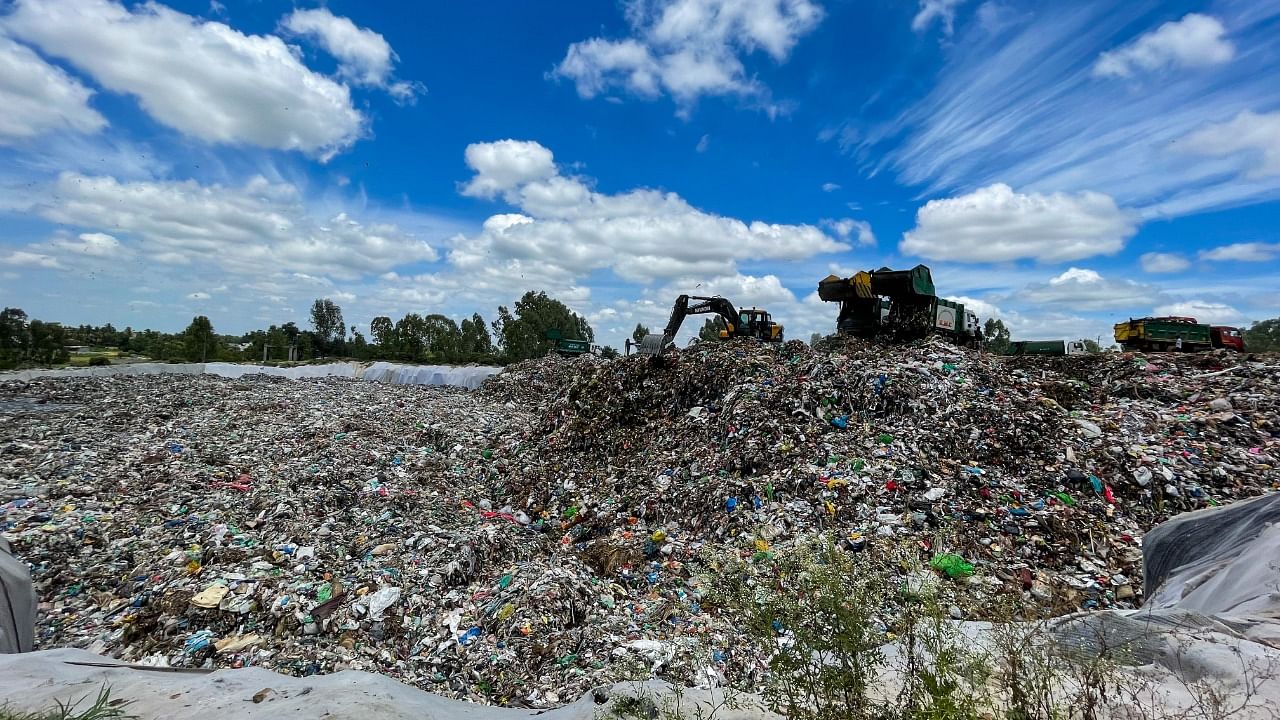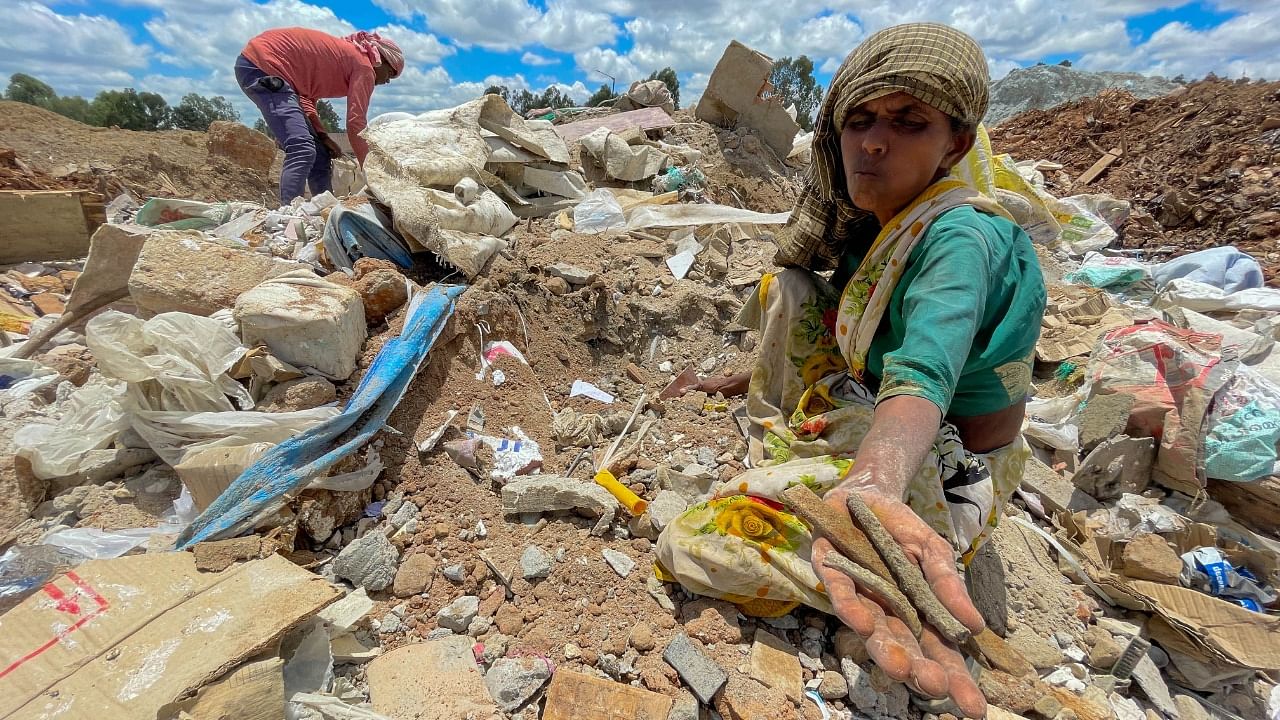

When an auto driver told us about the misery of living near the Mitaganahalli landfill, we looked it up on Google Maps. The village is a 45-minute drive from M G Road in Bengaluru. More than 3,100 tonnes of waste go there every day. It is surrounded by residential layouts. We began to look for people who could tell us the story of the village.
And we found Syed Imran Ali, 45, an enthusiastic biker. Met with a major accident in 2006, he is today supported by 138 "bolts" in his head, face and nose. He says he lost his sense of smell in the accident. "Good in a way. I can't smell the stench here," he laughs as he takes us around Bellahalli, his village next to Mitaganahalli where the landfill started first. A nauseating smell hung in the area — think of rotten vegetables and dead animals and worse!
On a quiet Saturday afternoon, we took a cab to Bellahalli. Right opposite the Bellahalli settlement stands an apartment complex promising to help buyers “embrace the brilliance of Zen living.”
We began exploring the area along with Imran. Cattle grazed in a small marshy patch opposite a tank. The water there looked dark and toxic, and an awful stench rose from the swamp. Expected, anyway.
The path to the landfill ran through land owned by his family. We crossed a weighing bridge where garbage vehicles stop, and walked up the hillocks. It was all part of the landfill, but it didn’t look that way. The BBMP, reprimanded by the High Court often, had mud-capped the landfills as soon as they were full. The garbage was visible here and there, but it wasn't yet as bad as the Mandur landfill.
Stinky pond
A couple of tankers were parked near a quarry measuring about 400 by 200 metres half-filled with leachate, the contaminated and stinky liquid that drains from landfills. An old man sat on a tanker filling it with the leachate piped from the quarry. The tankers, carrying 14,000 litres at a time, the driver told us, would be dumped on the land owned by the contractor on the outskirts of Bengaluru.
Why do this exercise? A leachate treatment plant located nearby gave us the answer. The plant was small — designed to process about 1 lakh litres of leachate a day. We also saw a methane bottling unit. A tank behind the plant was filled with treated water that looked cleaner than the leachate. BBMP officials admit privately that leachate is flowing into the quarry, and the plant is incapable of treating it all.
Imran told us that a part of the landfill and the plot on which the leachate treatment plant was built belonged to his family. His family used to run a stone crushing plant many years ago in the rocky parts here and grew ragi and other crops in stretches where water was available. The crushing unit was declared “a polluting operation” by the pollution control authorities and ordered shut.
In 2016, the BBMP started the first landfill in Bellahalli, 100 metres from here. Parts of private land were consumed by it. Once Bellahalli's quarry was full, it was the turn of other quarries in the area.
Listening to these stories, we walked towards a stone structure on a rocky hillock — standing on it is a small temple, painted with Rub-el-Hizb (Islamic star) and other Islamic symbols on its door and the front wall. Imran explained it was a 150-year-old temple built for Yogi Vemana, a saint famous among Telugu Hindu devotees in the area.
Traditionally, elders in Imran’s family worshipped the saint thrice a week and fed the devotees during festivals. A unique tradition, which probably even saved the hillock on which it stood, from becoming yet another quarry and a landfill.
We trudged up the mud-capped landfill, to see bubbles from a trench abutting the landfill. Methane, a harmful inflammable greenhouse gas, can catch fire with just a spark from a gelatin blast across the road.
Villagers later told us about an inferno triggered by a small fire some boys had lit — it took four days for the flames to subside, and acrid smoke covered the village. After this, it seems, the landfill shrunk in size, and the BBMP used it to dump waste there for an additional month.
Quarries and crusher units are operational on the rocky terrain. All landfills there have pipes meant for methane outlets, but have drowned in the garbage, we were told.
We then heard about a park. Piqued by the idea of a park near a landfill, we followed him to the brink of the landfill and saw what looked like a park. It was covered for the most part by the landfill. BBMP had set out to beautify the area with greenery, but its own landfill had destroyed it two years ago. There was also a bike racing track proposed here. It never got built.
Neglected backyard
We came down the hillock and took a walk in the colony next to the landfill. This ill-planned colony in Bellahalli has a predominantly Muslim and SC/ST population.
In the evenings, people living there said, the wind brings a foul odour to their doorsteps. When it rains, water mixed with leachate flows through the streets of Bellahalli settlement since the colony has no drainage. Snakes and insects are daily visitors during the monsoon. Various species of mosquitoes rule. Some residents have sent their children away to safety, to houses of relatives living elsewhere.
“The village was clean. There was no problem before the landfill was started six years ago. We have problems now, but who listens to us?” said Halim Khan, an old resident.
There is no source of clean drinking water for most houses. The government’s RO water kiosk helps with 20 litres of clean water for Rs 5 — a lifesaver indeed. However, not all can afford it. Such people drink borewell water. Children from their families often suffer from fluorosis, fever and water-borne infections.
Children study until Class 5 in an Urdu school and a Kannada school. About 80 Muslim children study in the Urdu school, with its own building. The Kannada school runs in a building offered by Munigangaiah, a resident. A staff told us every day at least 10-12 kids fall sick — especially children of migrant labourers who don’t have access to clean drinking water.
The nearest primary health centre (PHC) is in the Kannur village panchayat limits. But Bellahalli falls under the Agrahara Layout PHC. Officials at the two PHCs claimed there was no problem due to garbage or leachate!
Many people visit private doctors in the area, but a private doctor we met refused to share any information. However, Dr Muralidhar from the Agrahara Layout PHC said private doctors alert the PHC if they notice an outbreak of any kind. Health staff and ASHA workers visit the areas to initiate control measures.
The government has to provide a PHC for every 50,000 people, and Bellahalli, with a population of 3,000, doesn’t have one. A village that absorbs the state capital’s garbage has to walk 2.2 km to access healthcare.
And public transport is not easy to come by either. Lakshmi, 20, studies BCom in a college in Yelahanka. She walks a kilometre every day, come rain or shine, to catch a bus because buses are rarely operated from Bellahalli in a useful time band.
The sorrows of the village remain untold. A cow collapsed and choked to death one day when a part of the landfill caved in. Muniraju, whose cows worth Rs 6 lakh died after drinking leachate water, told us he got only Rs 20,000 by way of compensation. The villagers spoke about illnesses and human deaths being hushed up.
The BBMP sprays perfumed culture liquids on the leachate-ridden roads, but the people suffer in many ways. Property prices have gone down. Over the past six years, many have left the place to live elsewhere.
But on the other hand, the landfill provides a livelihood to many poor migrants — Biharis, Assamese, Bengalis and Burmese — ready to work amid the toxicity. Migrants settling in the area are mostly waste-pickers.
Imran kept talking throughout about the “mafia”, corruption, and how the government just descends on unsuspecting villages to dump unsegregated garbage. We rested for the night in his home in the village.
Leachate falls
Our plan for the second day was to visit the dumping spot. After 9 am, garbage vehicles started coming in. We circled around the landfill and went near a huge quarry, partially lined and holding leachate. In the centre stands an unquarried rock island with trees. It was a zen sight — of nature managing to survive amid all toxicity. Two live quarries were active adjacent to this. Wires used for gelatin blasts were strewn around. A huge pipe was immersed in the leachate water in one of the quarries, 100-150 feet deep.
The small quarry was a sight to behold. If this were a picnic trip, we’d have been happy that we spotted waterfalls — what we saw were leachate falls, flowing from upstream, where excavators were at work. That was where we had to reach — the current landfill.
A worker told me that the quarry work stopped because the leachate started entering the live quarries. Now the leachate was being pumped into the bigger quarry we had seen earlier. If not diverted, it flows onto the road and floods the area, he told us.
A woman grazing sheep said she had no problem with the landfill or leachate. A few people were busy trying to sort iron and plastic from the construction waste.
The zen amid dumping
Garbage compactors bearing BBMP signs were queued up along the way. Two people stood and collected money from every driver. Who knew what or who it was for?
We passed through a parallel walking path amid dense vegetation — all the while afraid of being bitten by snakes. In five minutes, we were standing in front of the monstrous damage unleashed by Bengaluru on the village. Two excavators were busy emptying and compacting the garbage dumped into the quarry. People there worked without safety shoes, gloves and masks.
It was all a pile of mixed garbage. Unopened green, yellow and black covers tumbled into the landfill from each vehicle. Vegetable peels, recyclable bottles, plastic items, diapers, sanitary napkins, paper, tender coconut shells, cardboard sheets, syringes, batteries, clothes… We saw so many items that should not have reached the landfill if the much-touted segregation and solid waste management policy had been followed strictly.
Ragpickers merrily roamed around holding bags, amid fresh garbage, picking whatever was of value, while vultures hovered above in the sky.
The landfill quarry's plastic lining floated on the leachate, indicating the failure of the “scientific” system the BBMP boasts of. The leachate from here formed the falls we had seen earlier.
Every batch of waste was sprayed with a culture to help it decompose faster and to stop the stench. But it looked futile — a foul odour prevailed, and flies and composting insects made merry.
Standing there, watching the sins of the city fall into the landfill while the excavators and compactors hummed, our senses were overcome by the miasma around. It was surreal and eerily meditative.
Just when we started back, a garbage vehicle took the reverse gear with the tune "Saare jahaan se accha…".